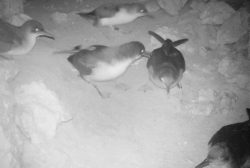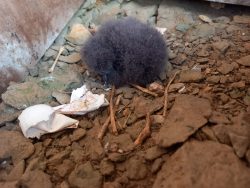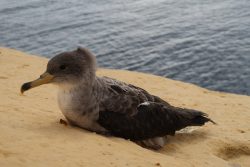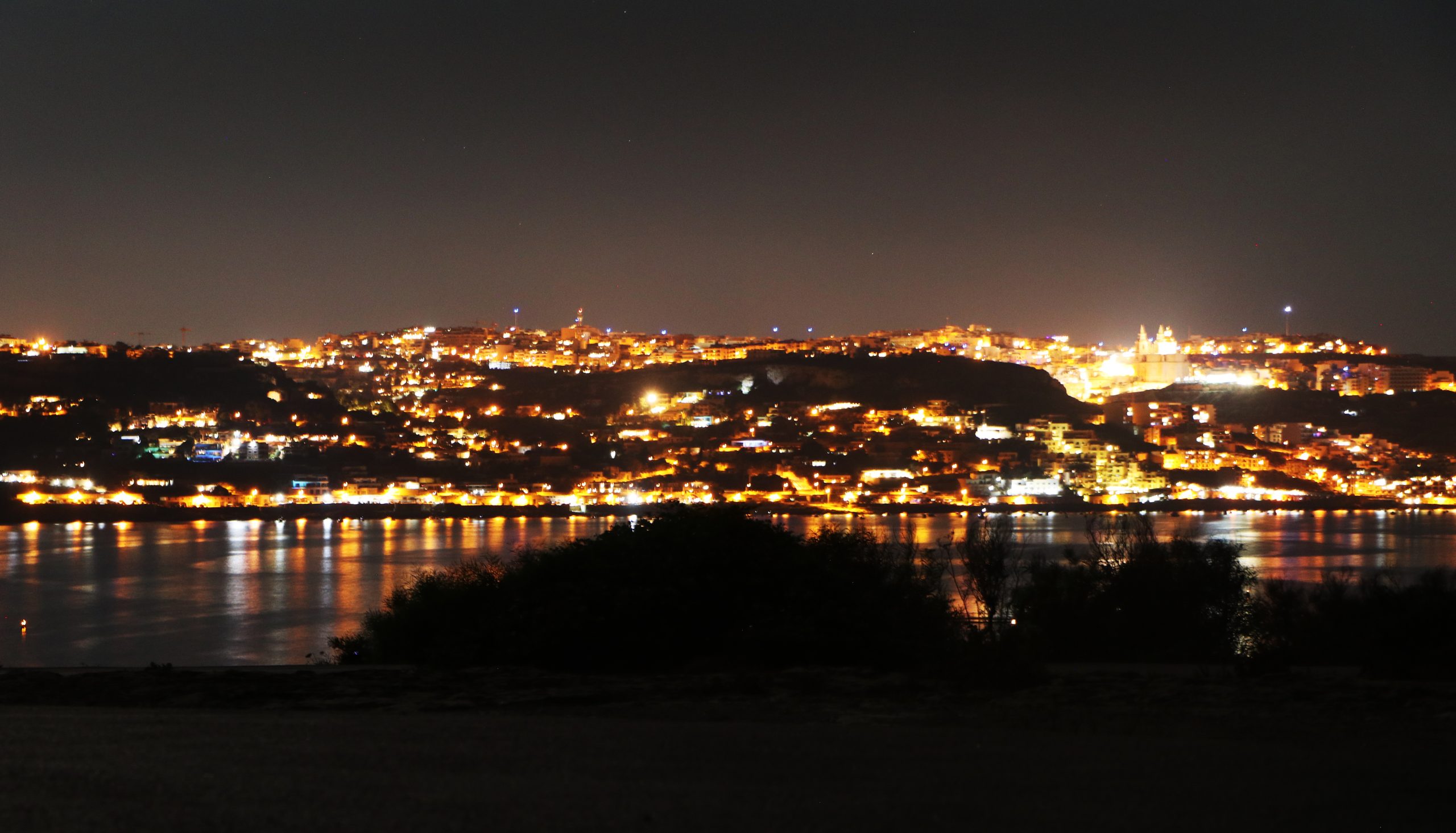As the first eggs were laid at the end of March, a new breeding season for the Yelkouan Shearwater just started. In a previous blog we understood how shearwaters could come back to their home even in the featureless ocean (in case you missed it, you can find it here). Seabirds don’t don this name for nothing – they belong to this environment and pass most of their life at sea. Yet, evolution didn’t provide any floating nest nor egg and they need to come back on land to breed.
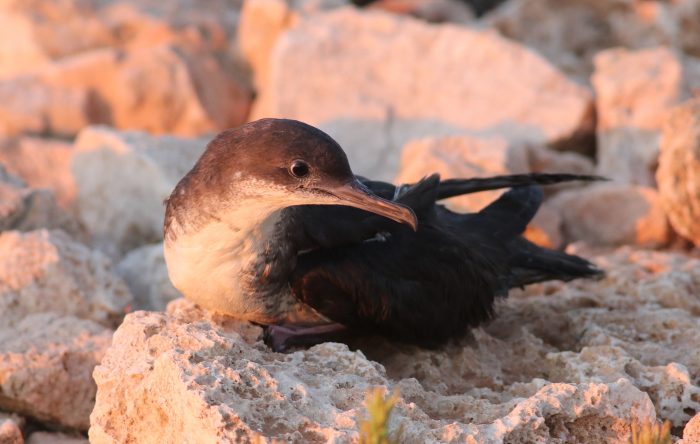
It is a really challenging period for them. How much do you know about the breeding season? In our first blog in this series, we explained how we equipped shearwaters with GPS tracking devices and followed them during the breeding season. We saw, for example that they are continuously going to the Gulf of Gabes in Tunisia four hundred kilometres away in a few days’ time. It is a period where they need to be efficient to bring back food to an impatient and growing chick, and luckily, they have developed different strategies and behaviours to do just that.
Can you imagine how much effort it is for them? What is their instinct telling them during the breeding season? In this blog, we will tell you more about their secret life and we will learn what it takes to have a successful breeding.
The meeting place
Each year, Yelkouan Shearwaters and the majority of the procellariiformes return to their colony a few months before the season starts. Generally, males start to come back first to ensure their nesting site is still available for another season. If it isn’t, males will commonly engage in disputes to ‘win back’ their site. Once their nests are secured, they will wait for the females to arrive. Pairs are life-long, and couples will reunite every year at the same nesting site after a prolonged period apart at sea.
For animals, there are some advantages and disadvantages to remain at the same location during their lifetime. Returning or “homing” in the same place every year means the birds are more knowledgeable about the environment, food, competitors and threats from predators in the area. This behaviour can also be disadvantageous if there is already a high density of birds or for the gene flow of a species, as individuals interact less with external members of other nesting sites, resulting in inbreeding, genetically weaker individuals, and lower ability to adapt to a changing environment. In order to avoid this, several seabird species visit different colonies including their natal one before attempting a first breeding and adopting a colony (Coulson 2011). They can decide on which one they will breed after these visits depending on density and competition or availability of food (Coulson 2016).
By the end of February, seabird couples would have their nest secured, and will be ready to begin the breeding season.
Time to sit on eggs!
Once reuniting with their partner, Yelkouan Shearwaters will meet several times at the nest location to court and mate until the end of February to mid-March before laying only one egg each season. Before laying, the female will perform a “pre-laying exodus” (Warham 1964), in which they will spend a long time at sea in a good foraging area to have enough strength to prepare a single large egg (Mallory 2008). Females will spend an average of 13 days at sea during this exodus and being far away from the colony allows them to access higher quality foraging areas without duties at the colony. On the other hand, males will spend this time defending the nest and prepare to take the first incubation shift (Gatt 2019).
After laying, both parents will take care of the egg incubating it one after the other. When we tracked Yelkouan Shearwater in 2021, one bird spent 11 days at sea between two shifts leaving her partner living on their reserve during that time. This was the longest we observed, and it took place after the female laid the egg, so it is likely that this prolonged period was required for her to replenish her reserves. They will incubate the eggs like that for 50 days relying on their partner to keep the egg warm when they are feeding at sea and preparing for the next stage; the chick rearing period.
For us biologists, it is a very intense period of work where we will begin to check the breeding success. We need to see all nests occupied for the new season and register the ones which will be monitored through the season. It is also a period when invasive species like rats can and will predate on eggs or chicks that are only a few days old. We are trying to prevent that by implementing biosecurity measures around the colony, baiting with rodenticide following an evidence-based grid map, having in place mechanical E2 Goodnature traps, camera traps and wax blocks to detect and control any intrusion into the colony.
Raising the hungry chick
After 50 days of incubation, an adorable little ball of fluff will be born and will be an unsatiable chick. They are never left alone during the first weeks by at least one of the parents until it will be big enough. Both parents will feed the chick alternatively. The older the chick will get, the longer they will be left alone, to an average of 3-4 days. Parents will alternate between short and longer trips, suspected to be a protective mechanism to compromise between the need of their chick and their own health (Granadeiro 1998). They need to go further to find better foraging areas and maintain their physical condition.
It is a hard time for parents and the risk is high, as shearwaters rely on pelagic food. It is a scarce and unpredictable resource (Mallory 2008). If the chick-rearing period is longer than usual, it has important effect on the parents and on the next season. If they extend the chick-rearing period, they delay their autumn migration and so, spend less time wintering and resting. During the following breeding attempt, they will lay smaller eggs, rear lighter chicks, overall having a lower breeding success (Annette 2016). Fledging date and chick mass are negatively correlated, with chicks fledging earlier generally being heavier (Perrins 1966).
Both parents are always trying their best and will rear the chick and continue to go back and forth at sea to provide food until July, 60 to 68 days after hatching, giving way to the next generation. Parents will leave the nest first and stop bringing food. Some days later the fledging will know that they will have to fly by themselves to feed and explore the ocean as a seabird.
Yelkouan Shearwater in distress: what you can do to help
The fledging period is also critical for shearwaters as they can get stranded on land after being disorientated by light pollution. In the months of July and August, you can help to keep an eye out for these lost birds, and call BirdLife Malta or the Environmental Protection Unit of the Police if you find one. These birds will be released after being thoroughly checked.
In the meantime, biologists from the seabird team at Birdlife Malta, along with other hard-working ornithologists around the Mediterranean will keeping working hard to monitor these precious seabird species, and helping these populations to have a fighting chance to survive into the future.
Bibliography
Annette L. Fayet, Robin Freeman, Akiko Shoji, Holly L. Kirk, Oliver Padget, Chris M. Perrins, Tim Guilford. Carry-over effects on the annual cycle of a migratory seabird: an experimental study. Journal of animal ecology (2016) Nov; pp.1516-1527.
John C. Coulson. The Kittiwake. 2011. T. & A. D. Poyser, London, U.K.
John C. Coulson. A Review of Philopatry in Seabirds and Comparisons with Other Waterbird Species. 2016.
Gatt, Marie Claire, Lago Paulo, Austad Martin, Bonnet-Lebrun, Anne-Sophie et al. Pre-laying movements of Yelkouan Shearwaters (Puffinus yelkouan) in the Central Mediterranean. (2019) Journal of ornithology ISSN: 2193-7192
Granadeiro JP, Nunes M, Silva MC, Furness RW. Flexible foraging strategy of Cory’s Shearwater, Calonectris diomedea, during the chick-rearing period. Anim Behav. 1998 Nov;56(5):1169-1176.
Mallory ML, Forbes MR, Ankney CD, Alisauskas RT. Nutrient dynamics and constraints on the pre-laying exodus of High Arctic Northern Fulmars. (2008) Aquat Biol 4:211–223.
N.I. Klomp, R.W. Furness Patterns of chick feeding in Cory’s Shearwaters and the associations with ambient light Colonial Waterbirds, 15 (1992), pp. 95-102
Perrins, C.M. Survival of young Manx Shearwaters Puffinus puffinus in relation to their presumed date of hatching. (1966) Ibis, 108, 132– 135.
Warham J. Breeding behaviour in Procellariiformes. (1964) Carrick R, Holgate M, Prevost J (eds) Biologie antarctique. Hermann, Paris, pp 389–394
By Marc Schruoffeneger, Seabird Research Officer
With support from the BirdLife Malta seabird team

